This summer, I have greatly enjoyed watching and photographing dragonflies and damselflies. I particularly like to take macro photos and whenever I review these I am particularly impressed by the size and complexity of these insects’ eyes. Dragonflies are among the most agile of flying insects, turning in an instant and at high speed, to take their prey with their forelegs and guiding it to their mouths. This action is so fast that it can only be captured by high-speed cameras. Their abilities are extraordinary; they can fly at nearly 50 kilometres per hour, turn in their own body length, fly inverted and backwards, hover like a helicopter and they are over 90% successful in capturing their prey. They can consume up to 100 mosquitoes every day but will also consume flies, butterflies, moths, beetles, wasps, bees and even other dragonflies. Perhaps even more remarkable is that they can live for up to 2 years but only fly for a few weeks. Most of their time is spent as nymphs that live underwater. Their nymphs are also fierce predators and they consume aquatic insects, insect larvae and small crustaceans, but they will also eat tadpoles and even small fish!
I have found that early morning just after sunrise, is the best time to take close-up photos of dragonflies. This is because in spring and summer dragonfly nymphs crawl from the water and climb reeds and blades of grass, and shed their skins to emerge as winged adults. They then sit motionless waiting for the first rays sunlight to dry and harden their wings. During this period, it is possible to pick a reed with the dragonfly clinging to it and hold it in front of the camera lens. The dragonfly can then be released unharmed by tempting it back onto another grass or reed stem.
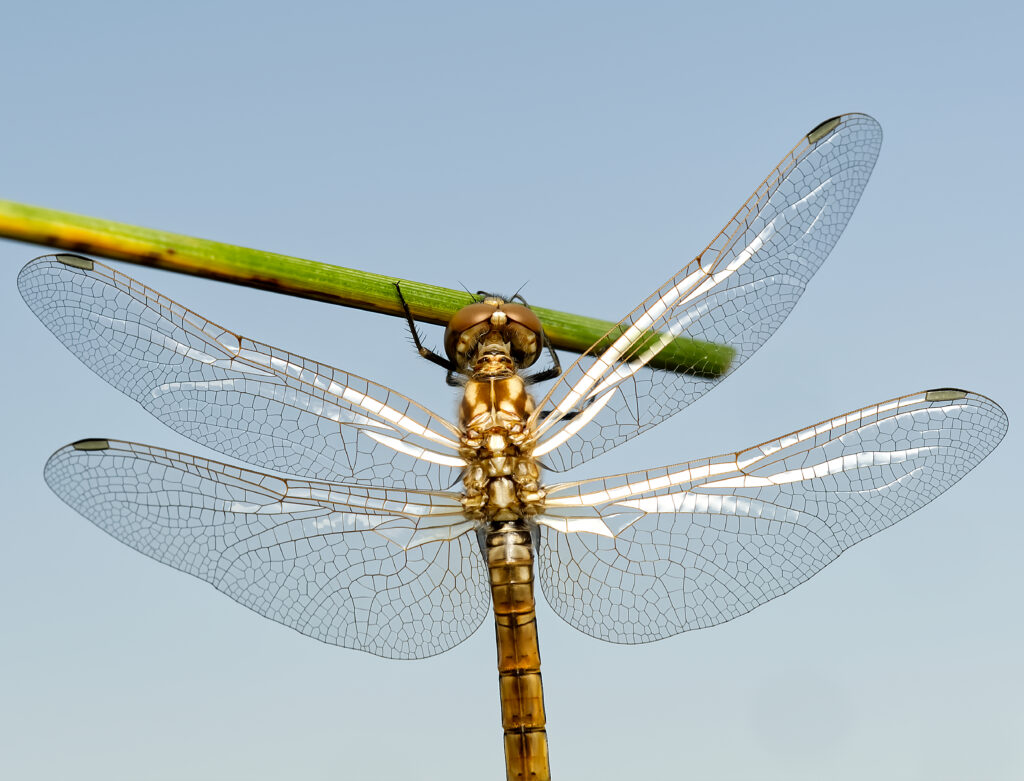
Figure 1. A newly emerged female Sympetrum sp. (sanguineum?) dragonfly hanging from a reed waiting for its wings to dry. Note the array of hairs on its neck that detect the angle of the head relative to the body. If you watch dragonflies closely you will often see them turn their heads to peer at you before they fly away. The larger facets in the upper part of the compound eyes are clearly visible. If I am correct in my identification of this dragonfly, the males are bright red – the body of this individual, a female, is mostly brown.
Dragonflies are among the most ancient of insects and they evolved more than 150 million years ago. Evolution has equipped them with extraordinary visual capacities. Like most flying insects they have two large compound eyes and a set of three much smaller simple eyes called ‘ocelli’. Their compound eyes consist of ~30,000 facets, each facet consists of a tiny lens that focus light on the photoreceptors that lie beneath. A facet views only a tiny piece of the world but apart from a small blind spot right behind the insect, the ensemble gives the dragonfly an almost 360 degree field of view. The ocelli are much smaller and less noticeable. Each ocellus consists of a group of about 1500 photoreceptors behind an individual lens. There are three ocelli arranged in a turret between the compound eyes. The middle one of these ‘simple’ eyes looks forward and the other two look out to the left and right. Each has a very wide angle of view. The role of these simple eyes is to detect the horizon and they are almost directly connected to the flight muscles of the dragonfly to enable nearly instantaneous corrections of pitch, roll and yaw. Working together with the compound eyes the ocelli stabilise the dragonfly’s flight enabling its extraordinary aerial acrobatic capabilities. Unlike human eyes that have photoreceptors tuned to red, green and blue light, those of dragonflies are tuned to up to 30 different wavelengths. Thus, they have a much greater ability to distinguish one colour from another and can see into the ultraviolet region of the spectrum. Like the compound eyes of many other insects, those of dragonflies have regions specialised for detecting particular features. For example, some the facets at the top of their eyes that mostly view the sky are more sensitive to blue and can also detect polarised light. The facets at the bottom of the eye and that mostly view the ground and the water surface are more sensitive to red and green.
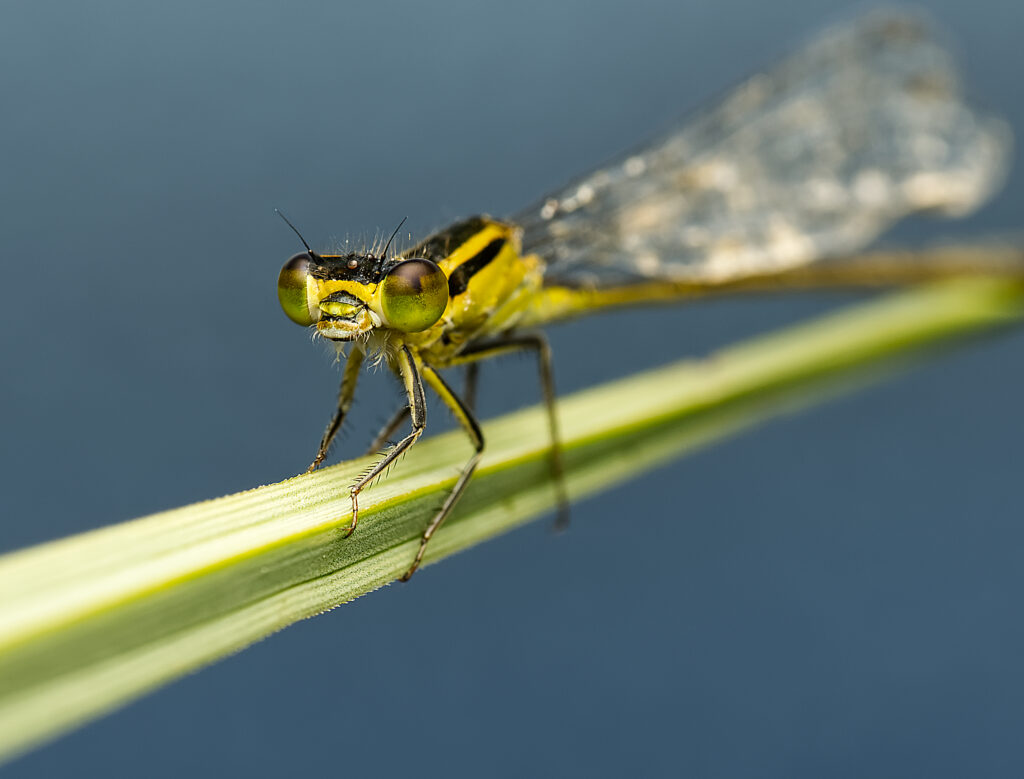
Figure 2. The compound eyes of this damselfly (Ischnura sp. ?) are divided into at least three regions. The top part of the eye is dark brown and views the sky. The lighter brown band below it views the horizon and the lower green area views the ground. The three simple eyes lie on the black band of cuticle between the two antennae.
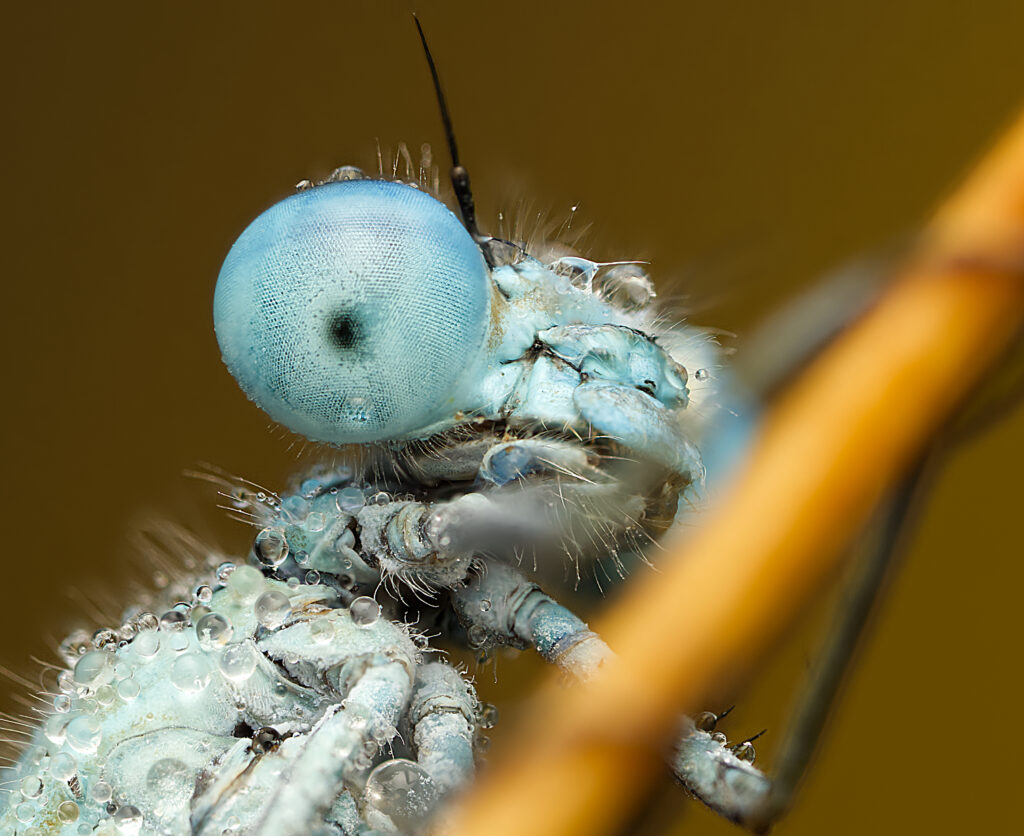
Figure 3. Extreme close-up of the head of a damselfly chosen to illustrate the pseudopupil. The facets in the black spot are those that are looking directly into the camera. The dew drops are an indication of how early in the morning it was. While their wings are wet with dew, most dragon- and damselfies are reluctant to fly enabling you to get very close to them. The head of this damselfly is less than the width of a matchstick. Note that the eyes are almost on stalks. Placing the eyes as far apart as possible in such a small insect improves stereo vision and depth perception.
Dragonflies are diurnal; they are mostly active during the day and rest at night. However, true dragonflies, but not damselflies, fly in twilight, just before and after sunset. It is then that numerous small insects, such as midges and flies, form swarming groups and moths start flying. Many true dragonfly species are active at these times and are very efficient at catching insects, detecting them as silhouettes against the light of the evening sky. Such activity utilizes the the blue-sensitive facets at the top of the eye. In the daytime, territorial males are looking down on the environment and pay attention to other males of the same species that usually approach from the surroundings, where both the dragonflies and the vegetation reflect more green and red light. It is the facets in the lower region of the dragonfly’s compound eye that are involved in chasing of other males though they are also well suited to detecting prey against the surface of the water and surrounding foliage. However, the importance of the top part of the eye in prey capture is supported by the behaviour of dragonflies. They usually approach their prey from below, tipping upward at the final moment of approach to secure the prey with their outstretched legs. Some species of dragonflies are sit-and-wait predators, perching on the ground or on vegetation, taking off to intercept small insects as they fly by. Others (‘hawkers’) fly continuously throughout the day, periodically swooping up to grab insects passing overhead.
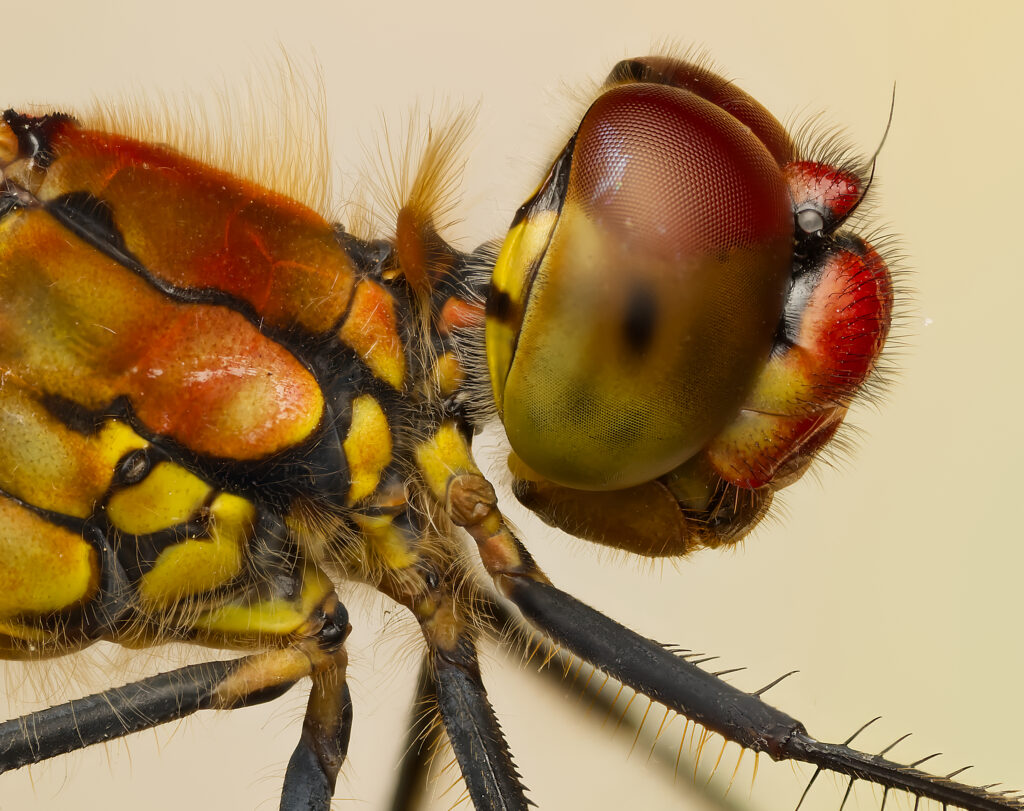
Figure 4. A male Sympetrum sanguineum – I think the eyes of this insect can be divided into four regions: one is red-brown and looking up, another lighter brown and looking forward, one green and looking down and another of similar colour looking backwards. The pseudopupil is visible in the middle region. One of the lateral simple eyes is visible close to the antenna. The simple eyes in this species are on a turret giving them a clear view of the horizon unimpeded by the bulbous compound eyes. To get this picture, I netted the dragonfly, held it gently by its wings and took a stack of photographs against a coloured background. The photos were then combined to give a greater depth of focus. The insect flew away unharmed.
The regional specialisation of the eyes of dragonflies are clearly visible from the outside. Some regions are of different colours to others. These colours are not he result of the pigments within the photoreceptors that are designed to capture photons and turn them into electrical signals but rather are due to the presence of coloured granules (screening pigments) that prevent light from spreading between facets and thus blurring the image. Also, the diameters of the facets of the eye vary from one region to another. Smaller facets provide better acuity (detail) and larger ones catch more light providing greater sensitivity. Another notable feature of the compound eyes is the presence of one or more ‘pseudopupils’. These are dark spots which move across the eye as you move around the insect. This movement occurs because the facets that one observes “head-on” (i.e. along their optical axes) absorb the incident light, while those to one side reflect it. The pseudopupil therefore reveals which facets are aligned with the axis along which the observer is viewing the insect. The size of the pseudopupil reflects the area of the eye dedicated to looking in that direction. Though their habits are somewhat different, most of what I say above also applies to damselflies. Their eyes also demonstrate regional specialisation and are all the more remarkable for the fact that they protrude so far from the side of their heads.
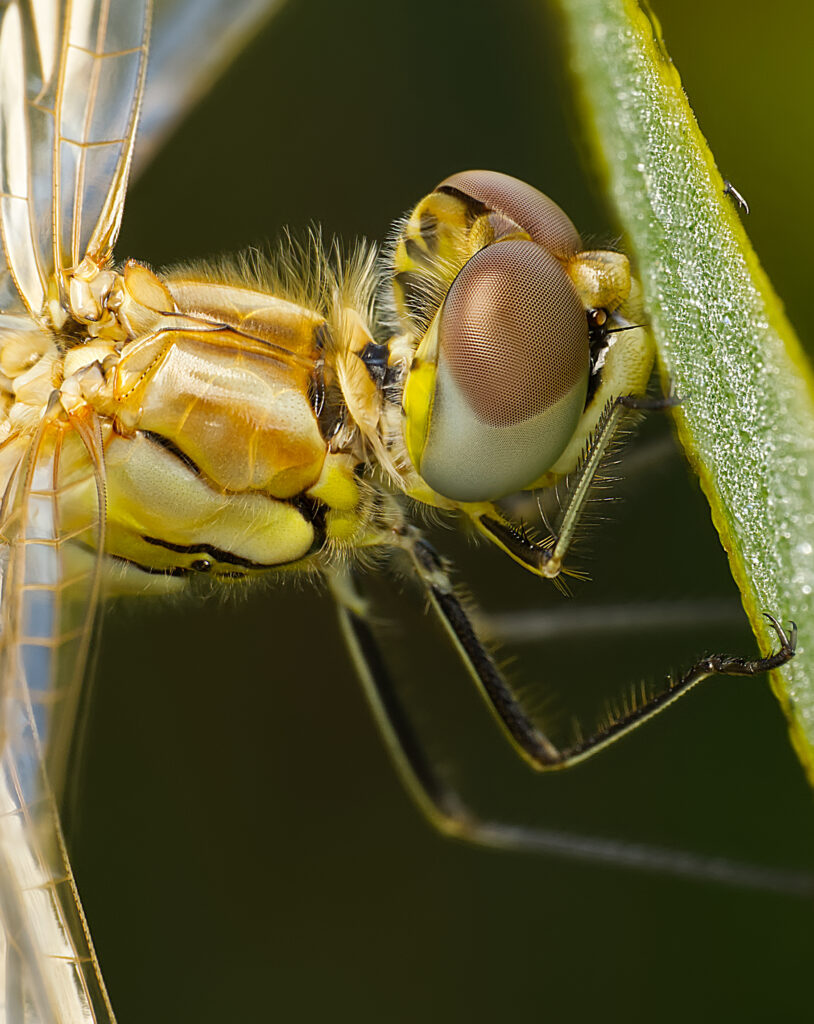
Figure 5. A Sympetrum sp. pictured to better illustrate the dramatic differences in the size of the facets in the top region of the eye compared to elsewhere. The top facets are about three times the diameter of those in the lower part.
Recently and somewhat sadly, there has been a lot of interest in how it is that the brains of dragonflies are able to select and follow prey objects. Swarming of small insects may help in their survival by confusing a predator and preventing it from ‘locking on’ to any individual. Neither dragonflies nor damselflies are fooled by this strategy. I say ‘sadly’ because an understanding of the mechanisms used by these insects in capturing their prey has aroused interest from the military…imagine the potential relevance that dragonfly and damselfly eyes and the behaviours they drive, might have in detecting and destroying drones.
Leave a Reply